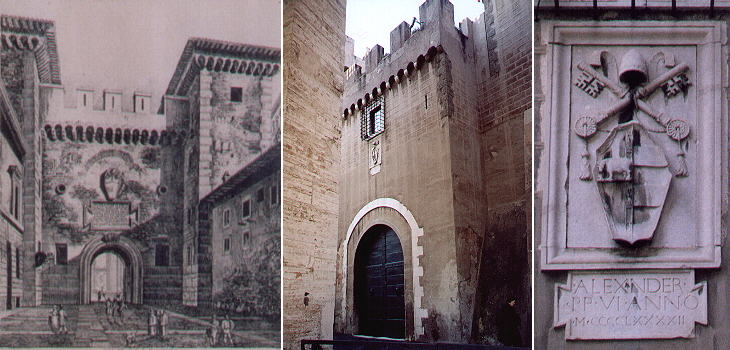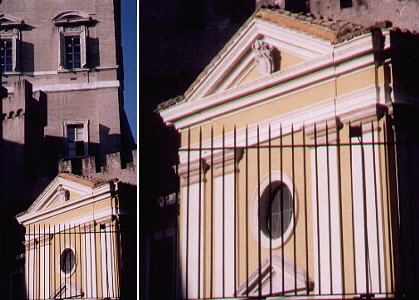|
TIMEO HOMINEM UNIUS LIBRI (St. Thomas Aquinas) (I fear the man who trusts one book only)   In plate 15: Porta di S. Spirito Towards Ospedale di S. Spirito
The Hospital of S. Spirito in Sassia was enlarged by several popes whose initiatives
are celebrated by inscriptions and coats of arms. Alexander VII is celebrated by a very lengthy inscription above one of the lateral entrances to the hospital. The etching by Giovanni Battista Falda
shows the site a few years after the gate was built. Next to the gate there is a 1655 madonnella: under the glass there are some silver hearts, ex-voto offered in pursuance of a vow.
In 1473, in order to facilitate the orderly flow of pilgrims between the two sides of the Tiber in the forthcoming 1475 Jubilee, Pope Sixtus V built on the ruins of an
ancient bridge, Ponte Sisto. The bridge increased the importance and the real estate value of Campo dei Fiori and in 1483 the pope
promoted the cleaning and redesign of the area. An inscription, now at the beginning of Via dei Balestrari (crossbow makers), celebrates the
initiative.
The northern side of the street leading from Piazza di Pescheria to
Piazza Giudia is flanked by Renaissance houses.
A recent restoration has given emphasis to the original architectural design of two buildings belonging to the Fabi family,
who pretended to descend from the Gens Fabia a family who played a major role in Ancient Rome during the Republic.
The buildings were embellished by a decorated loggia, closed at a later stage to obtain some more rooms.
The "target" of the 10 books published by Vasi between 1746 and 1761was not the travelling foreigner, but rather
the faithful pilgrim: this explains why in his view of Piazza di Spagna he chose to show Palazzo di Propaganda Fide, one of the most important Roman Catholic institutions, rather than
the Spanish Steps. Mariano Vasi, who continued to sell his father's books and etchings, realized that his
customers were mainly foreign travellers, in some cases even despisers of the Roman religious institutions. The original view of Piazza di Spagna was replaced by Scalinata (steps) in
Piazza di Spagna an etching falsely attributed to Giuseppe Vasi, because the obelisk at the top of the steps was erected in 1789, while Vasi passed away in 1782.
January 15, 2005
The Vatican was not included in the walls of Ancient Rome: in 846 a Saracen raid caused enormous damage
to the basilica and the adjoining buildings. Pope Leo IV in 849-52 erected a fortified wall around the basilica
and the narrow strip of land between it and Castel Sant'Angelo.
It is uncertain whether there were any gates in these walls when they were initially built. Anyhow at one point the popes decided to
open a gate allowing access to the Vatican from the north through Via Trionfale. The gate was mainly used by pilgrims and the street leading to the gate became
known as Via del Pellegrino and eventually the gate itself was named after a church dedicated to the pilgrims. SS. Martino e Sebastiano degli Svizzeri
SS. Martino e Sebastiano degli Svizzeri was built by Pope Pius V in 1568 to serve as chapel for the Swiss Guards,
whose barracks were located next to Porta S. Pellegrino: the upper part of the church can be seen
from Piazza S. Pietro immediately below Palazzo Apostolico.
Search my site! Go to my Home Page |
All images © 2005 by Roberto Piperno. Write to romapip@quipo.it (alternative e-mail address at romeartlover@katamail.com)






